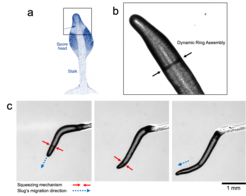Active Biological Matter
Collective Cell Migration in Dictyostelium Slug

Collective cell migration in the snail Dictyostelium Discoideum. a) Fruiting body of Dictyostelium Discoideum (the tip part points out the region of adherens junctions). b) Optical microscope image of the migrating snail Dictyostelium Discoideum on soft substrate. c) Time-lapse images of the migrating snail showing how the dynamic ring compresses the snail and changes its movement course.
This work addresses collective cell migration in a model multicellular organism, namely Dictyostelium Discoideum, known as Dicty cells. The idea that certain aspects of animal multicellularity have evolved prior to the divergence of fungal metazoans and social amoebae is considered. The dicty cell, as a non-metazoan social amoeba, is an important model cell because it has a 24-hour life cycle and evolves from a unicellular organism to a fully developed multicellular organism (migratory snail). Therefore, it provides an opportunity to follow the pattern formation and dynamics behind the development into a multicellular organism. Cell differentiation and coordination to assign different functions to each cell type are the reason for the collective pattern formation of the aggregation.
We study the migration of the Dictyostelium Discoideum snail by examining it during fixation and culmination as a fruiting body. In our set-up, the lack of physical conditions for culmination of the fruiting body results in prolonged (1-2 days) migration of the snail body. We are investigating cell organization and dynamics during differentiation, particularly the stalk cells which are responsible for the mechanical properties and migration of the snail body. The results of these studies show dynamic self-organization of stalk cells that exert a compressive force to support the migration of the snail on soft substrates. Using these experiments, we foresee to derive predictions about tissue organization in metazoans (close relatives of Dictyostelium Discoideum) and provide a new conceptual framework for studies of early animal evolution.
1- Nature 408, 727–731 (2000). https://doi.org/10.1038/35047099
2- Science, vol 314, 661–663 (2006). DOI: 10.1126/science.1130670
3- Developmental Cell 23, 533–546, 2012. https://doi.org/10.1016/j.devcel.2012.06.008
